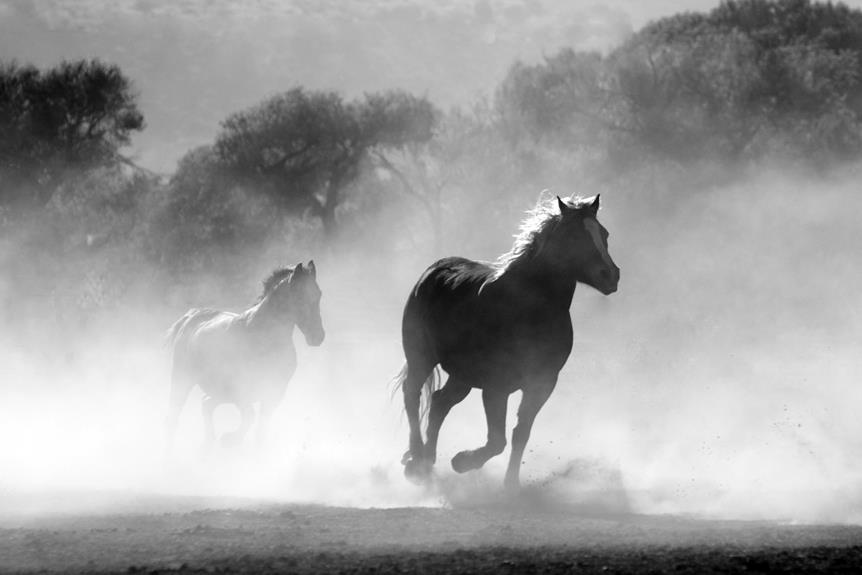Imagine yourself as an intrepid explorer, venturing into the untamed wilderness with the goal of taming a wild horse. Like a delicate dance between two beings, the process of taming a horse requires patience, understanding, and a gentle touch.
But fear not, for within these words lies the key to unlocking the secrets of horse taming. Step by step, we will guide you through the intricate art of building trust, introducing training techniques, and establishing a bond that will leave you in awe.
So, saddle up and prepare yourself for an extraordinary journey into the world of horse taming, where the rewards are as boundless as the open plains themselves.
Key Takeaways
- Understanding horse behavior is crucial in taming a horse.
- Building trust through groundwork exercises is essential.
- Introducing basic training techniques helps establish clear communication.
- Establishing a consistent routine and nurturing a strong bond through positive reinforcement are key factors in taming a horse.
Understanding Horse Behavior
To effectively tame a horse, it's crucial to have a deep understanding of their behavior. Horses have a strong flight response and can easily be spooked by sudden movements or loud noises. This means that you need to approach them calmly and avoid any sudden gestures or loud sounds.
Horses also use body language to communicate their feelings and intentions. For example, pinned ears indicate aggression or fear. By learning to read their body language, you can better understand their emotions and respond appropriately.
Understanding herd dynamics is another important aspect of understanding horse behavior. Horses are social animals and often follow a lead horse within their herd. By recognizing this hierarchical structure, you can establish yourself as a trusted leader when taming a horse.
Additionally, horses are sensitive to human emotions and can pick up on subtle cues. It's important to approach them with confidence and remain calm, as they can sense any nervousness or fear. By observing signs of stress, discomfort, or relaxation in horses, such as tail swishing or relaxed ears, you can better communicate and handle them.
Building Trust Through Groundwork
Understanding horse behavior is essential when it comes to building trust through groundwork. Spending time with the horse on the ground is crucial in establishing a connection and fostering trust before riding. Groundwork exercises such as lunging, leading, and desensitization are effective methods to create a strong bond with your horse.
By paying attention to your horse's body language and responding accordingly during groundwork, you can build trust and understanding between the two of you. It's important to remember that groundwork helps the horse learn to respect and trust the handler, setting the foundation for a positive relationship.
Consistency and patience are key during groundwork sessions, as they can help develop a strong partnership and trust between you and your horse. Taking the time to build trust through groundwork won't only enhance your safety while riding, but it will also create a solid foundation for a successful and fulfilling partnership with your horse.
Introducing Basic Training Techniques
Gaining the horse's trust through gentle and consistent interactions is the first step in introducing basic training techniques. Once you have established a foundation of trust, you can begin to teach your horse new behaviors using positive reinforcement. This can be done by rewarding desired behaviors with treats and praise, which will motivate your horse to continue performing them.
To further enhance your training sessions, it is important to incorporate basic groundwork exercises. These exercises help establish respect and clear communication between you and your horse. Some examples of basic groundwork exercises include leading your horse in different directions, backing up, and yielding their hindquarters.
As you progress in your training, it is also crucial to gradually introduce your horse to common training equipment, such as a halter and lead rope. This will allow you to have more control and guide your horse's movements effectively.
By focusing on building a strong foundation of trust and respect, you are setting the stage for more advanced training techniques. Remember to always be patient and consistent in your approach, as it takes time to tame a horse and develop a strong bond with them.
To help you visualize the process of introducing basic training techniques, here is a table showcasing the emotional journey you and your horse may experience:
| Stage | Emotions | Actions |
|---|---|---|
| Trust-building | Uncertainty, caution | Gentle grooming, spending time in the horse's presence |
| Positive reinforcement | Motivation, excitement | Offering treats and praise for desired behaviors |
| Groundwork exercises | Respect, communication | Practicing leading, backing up, and yielding |
| Equipment introduction | Curiosity, adaptability | Gradually introducing halter and lead rope |
Establishing a Consistent Routine
After building a foundation of trust and introducing basic training techniques, the next step in taming a horse is to establish a consistent routine. This routine will provide structure and predictability for the horse, helping them feel secure and comfortable in their environment. It also allows for the reinforcement of good behavior and the learning of new skills.
Here are some key steps to consider when establishing a consistent routine for your horse:
- Set specific times for feeding and grooming the horse every day. This will help the horse develop a sense of routine and anticipate their daily needs.
- Establish a regular exercise schedule to keep the horse healthy and fit. Whether it's daily turnout or scheduled riding sessions, consistency in exercise is essential for the horse's physical and mental well-being.
- Create a consistent bedtime routine to help the horse wind down and prepare for rest. This can include activities such as a final grooming session, a quiet walk, or turning off the lights in the stable.
Nurturing a Strong Bond Through Positive Reinforcement
To nurture a strong bond with your horse, utilize positive reinforcement techniques that involve gentle body language, rewards, and quality time spent engaging in activities the horse enjoys. By approaching your horse with calm and respectful body language, you establish trust and show that you value its comfort. Rewarding your horse with treats, pats, and soothing words when it displays desired behavior reinforces positive actions and encourages it to continue behaving in that manner. Spending quality time with your horse, engaging in activities such as grooming and bonding, not only strengthens the connection between you but also allows the horse to associate positive experiences with your presence. Clicker training or verbal praise can be used to communicate approval and encouragement, further fostering a positive association with desired behaviors. By consistently employing these positive reinforcement techniques, you can create a harmonious and mutually respectful relationship with your horse.
| Positive Reinforcement Techniques | Benefits |
|---|---|
| Gentle body language | Establishes trust and respect |
| Rewards | Reinforces positive behaviors |
| Quality time spent together | Strengthens the bond |
Frequently Asked Questions
What Do You Need to Tame a Horse in Minecraft?
To tame a horse in Minecraft, you need patience and persistence. Hop on its back and keep going, despite its initial resistance. Once tamed, a saddle is required for control.
How Do You Tame a Horse Easily?
To tame a horse easily, approach it calmly and slowly. Use soothing techniques and continuous gentle pressure to gain its trust. Once tamed, register and manage the horse at a stable.
Why Can't I Tame a Horse in Minecraft?
You can't tame a horse in Minecraft because it requires patience and persistence. Unlike real-life horses, Minecraft horses need to be approached slowly and crouching to avoid scaring them before you can even attempt taming them.
Are Horses Hard to Tame?
Taming horses can be challenging, but with the right techniques, it becomes easier. Using patience, persistence, and the proper tools, such as saddles or soothing methods, you can successfully tame a horse.
Conclusion
Taming a horse in Minecraft is a fulfilling experience that requires patience and persistence. By approaching the horse slowly and soothing it, players can begin the taming process. Once tamed, players can ride the horse and have full control over its movements.
Remember to equip a saddle and register the horse at a stable for better management. By following these steps and nurturing a strong bond, you can have a loyal companion in your Minecraft adventures.



0 Comments